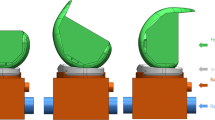Abstract
We developed a method to assess the accuracy of an image-free resurfacing hip arthroplasty navigation system in a proximal femur with normal and abnormal anatomy. A phantom lower limb allowed deformation in varus/valgus and ante-retroversion. At specific points during the simulated surgical procedure, information was compared between a digital caliper and the computer navigation system angular measurements. Repeated serial tests were undertaken. In the setting of normal anatomical alignment of the proximal femur, the mean error of the system characterised as the difference between the measured computer navigation and caliper angles was 0.6° in the frontal plane and 3.4° in the lateral plane. In the setting of abnormal anatomical alignment, the mean error was 0.4° in the frontal plane and 2.1° in the lateral plane. This is the first study designed to assess the accuracy of a femoral navigation system for resurfacing hip arthroplasty in normal settings and in the presence of angular deformity. The study demonstrates satisfactory in-vitro accuracy.
Résumé
Nous avons développé pour le resurfaçage de la hanche une méthode d’évaluation de la navigation sans image au niveau du fémur proximal sur des fémurs normaux et anormaux. Un fantôme de membre inférieur montrant des déformations en varus et en valgus ainsi qu’en anteversion a été utilisé. Dans le cadre d’un fémur normalement aligné, l’erreur moyenne est caractérisée par la différence entre la mesure de la navigation et l’angle mesuré par le gonomètre de 0,6° dans le plan frontal, de 3,4° dans le plan profil. Dans le cadre d’un fémur anormalement aligné, l’erreur moyenne a été de 0,4° dans le plan frontal et de 2,1° pour le profil. Il s’agit de la première étude montrant l’intérêt de la navigation lors du resurfaçage de la hanche qu’il s’agisse d’un fémur normal ou qu’il s’agisse d’un fémur déformé. Cette étude in vitro est satisfaisante.




Similar content being viewed by others
References
Barrett ARW, Davies BL, Gomes MPSF et al (2007) Computer-assisted hip resurfacing surgery using the Acrobot navigation system. J Eng Med 221:773–785
Beaule PE, Lee JL, Le Duff MJ et al (2004) Orientation of the femoral component in surface arthroplasty of the hip: a biomechanical and clinical analysis. J Bone Joint Surg [Am] 86-A:2015–2021
Cobb JP, Kannan V, Brust K, Thevendan G (2007) Navigation reduces the learning curve in resurfacing total hip arthroplasty. Clin Orthop Rel Res 463:90–97
Daniel J, Pynsent PB, McMinn DJ (2004) Metal on metal resurfacing of the hip in patients under the age of 55 years with osteoarthritis. J Bone Joint Surgery [Br] 86:177–184
Davis ET, Gallie P, Macgroarty K et al (2007) The accuracy of image-free computer navigation in the placement of the femoral component of the Birmingham Hip Resurfacing. A cadaveric study. J Bone Joint Surgery [Br] 89:557–560
Dorr LD, Hishiki Y, Wan Z et al (2005) Development of imageless computer navigation for acetabular component position in total hip replacement. Iowa Orthop J 25:1–9
Hess T, Gampe T, Kottgen C, Szawlowski B (2004) Intraoperative navigation for hip resurfacing: methods and first results. Orthopade 33:1183–1193 (in German)
Hodgson AJ, Inkpen KB, Shekhman M et al (2005) Computer-assisted femoral head resurfacing. Comput Aided Surg 10:337–343
Hodgson A, Helmy N, Masri BA et al (2007) Comparative repeatability of guide-pin axis positioning in computer-assisted and manual femoral head resurfacing arthroplasty. Proc Inst Mech Eng 221:713–724
Krüger S, Zambelli PY, Leyvraz PF, Jolles BM (2007) Computer-assisted placement technique in hip resurfacing arthroplasty: improvement in accuracy? Int Orthop. Online First 24 Aug 2007
Leenders T, Vandevelde D, Mahieu G, Nuyts R (2002) Reduction in variability of acetabular cup abduction using computer assisted surgery: a prospective and randomized study. Comput Aided Surg 7:99–106
Pitto RP, Graydon AJ, Bradley L et al (2006) Accuracy of a computer assisted navigation system for total knee replacement. J Bone Joint Surg [Br] 88:601–605
Pitto RP (2008) The trochanteric slide osteotomy approach for resurfacing hip arthroplasty. Int Orthop. Online First 21 May 2008
Shimmin AJ, Back D (2005) Femoral neck fractures following Birmingham hip resurfacing. A. national review of 50 cases. J Bone Joint Surg [Br] 87:463–464
Sikorski JM, Chauhan S (2003) Computer-assisted orthopaedic surgery: do we need CAOS? J Bone Joint Surg 85:319–323
Sparmann M, Wolke B, Czupalla H (2003) Positioning of total knee arthroplasty with and without navigation support. J Bone Joint Surg [Br] 85:830–835
Acknowledgements
The authors wish to thank Vinod Suresh for statistical analysis assistance and Lawrence Anderson for preparation of the technical drawings.
Author information
Authors and Affiliations
Corresponding author
Rights and permissions
About this article
Cite this article
Pitto, R.P., Malak, S. & Anderson, I.A. Accuracy of a computer-assisted navigation system in resurfacing hip arthroplasty. International Orthopaedics (SICOT) 33, 391–395 (2009). https://doi.org/10.1007/s00264-008-0644-6
Received:
Revised:
Accepted:
Published:
Issue Date:
DOI: https://doi.org/10.1007/s00264-008-0644-6




